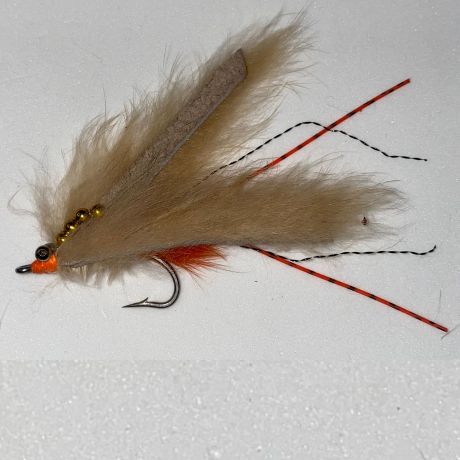Avalon Permit Saltwater Fly Pattern:
The Avalon Permit Fly is a well-known saltwater pattern designed specifically for targeting permit, though it can also be effective for other species like bonefish and tarpon. Developed in Cuba, this fly mimics crabs and small crustaceans, which are primary food sources for permit. Its unique design and movement make it one of the go-to patterns for saltwater flats flats fishing
Materials:
1. Hook: Strong saltwater hook, typically sizes 4 to 6. Common choices include the Gamakatsu SL12S or Mustad 3407.
2. *Thread:* White or tan, 6/0 or 8/0, depending on the hook size and preferred thickness.
3. Eyes: Dumbbell eyes (medium to large) for weight, usually in brass or lead. These give the fly the needed weight to sink quickly and create a jigging action when stripped.
4. Body:
– Underbody: Gold, silver, or pearl tinsel to provide some flash.
– Overbody: Tan, brown, or olive synthetic material such as chenille or craft fur, often tied in with rubber legs for a more natural look.
5. Tail: A few strands of gold and pearl flashabou or krystal flash, tied in sparsely to add a hint of shine.
6. Shellback: A piece of tan or olive Swiss straw (raffia) pulled over the top of the body to give a crab or shrimp-like appearance.
7. Legs: Orange or tan sili legs (silicone) to imitate crab legs. These should be tied on both sides of the fly for a natural side-to-side movement.
8. Beads: One of the unique aspects of the Avalon fly is its use of glass beads (often orange) strung on a piece of monofilament, looped at the bottom of the hook. This adds movement and clicks to imitate the sound of crabs scurrying along the seafloor.
9. Wing: Sparse tan or brown craft fur or synthetic fibers to imitate the fins of a small crustaceans
Target Species:
The Avalon Permit Fly is primarily designed for *permit*, one of the most challenging species to catch on the flats. However, it is also highly effective for other saltwater species such as bonefish and tarpon, particularly in situations where these fish are feeding on crabs or small shrimp.
The combination of weighted eyes, rubber legs, and the unique bead rigging makes this fly extremely lifelike in both appearance and movement, drawing the attention of finicky permit as they search for crustaceans on the flats.





